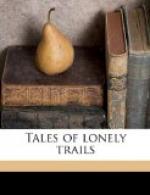[Illustration: IN THE CENTER OF THE SALT-INCRUSTED FLOOR OF DEATH VALLEY, THREE HUNDRED FEET BELOW SEA LEVEL]
I met only one prospector during my stay in Death Valley. He camped with us. A rather undersized man he was, yet muscular, with brown wrinkled face and narrow dim eyes. He seemed to be smiling to himself most of the time. He liked to talk to his burros. He was exceedingly interesting. Once he nearly died of thirst, having gone from noon one day till next morning without water. He said he fell down often during this ordeal, but did not lose his senses. Finally the burros saved his life. This old fellow had been across Death Valley every month in the year. July was the worst. In that month crossing should not be attempted during the middle of the day.
I made the acquaintance of the Shoshone Indians, or rather through Nielsen I met them. Nielsen had a kindly, friendly way with Indians. There were half a dozen families, living in squalid tents. The braves worked in the fields for Denton and the squaws kept to the shade with their numerous children. They appeared to be poor. Certainly they were a ragged unpicturesque group. Nielsen and I visited them, taking an armload of canned fruit, and boxes of sweet crackers, which they received with evident joy. Through this overture I got a peep into one of the tents. The simplicity and frugality of the desert Piute or Navajo were here wanting. These children of the open wore white men’s apparel and ate white men’s food; and they even had a cook stove and a sewing machine in their tent. With all that they were trying to live like Indians. For me the spectacle was melancholy. Another manifestation added to my long list of degeneration of the Indians by the whites! The tent was a buzzing beehive of flies. I never before saw so many. In a corner I saw a naked Indian baby asleep on a goat skin, all his brown warm-tinted skin spotted black with flies.
Later in the day one of the Indian men called upon us at our camp. I was surprised to hear him use good English. He said he had been educated in a government school in California. From him I learned considerable about Death Valley. As he was about to depart, on the way to his labor in the fields, he put his hand in his ragged pocket and drew forth an old beaded hat band, and with calm dignity, worthy of any gift, he made me a present of it. Then he went on his way. The incident touched me. I had been kind. The Indian was not to be outdone. How that reminded me of the many instances of pride in Indians! Who yet has ever told the story of the Indian—the truth, the spirit, the soul of his tragedy?
Nielsen and I climbed high up the west slope to the top of a gravel ridge swept clean and packed hard by the winds. Here I sat down while my companion tramped curiously around. At my feet I found a tiny flower, so tiny as to almost defy detection. The color resembled sage-gray and it had the fragrance of sage. Hard to find and wonderful to see—was its tiny blossom! The small leaves were perfectly formed, very soft, veined and scalloped, with a fine fuzz and a glistening sparkle. That desert flower of a day, in its isolation and fragility, yet its unquenchable spirit to live, was as great to me as the tremendous reddening bulk of the Funeral Mountains looming so sinisterly over me.




